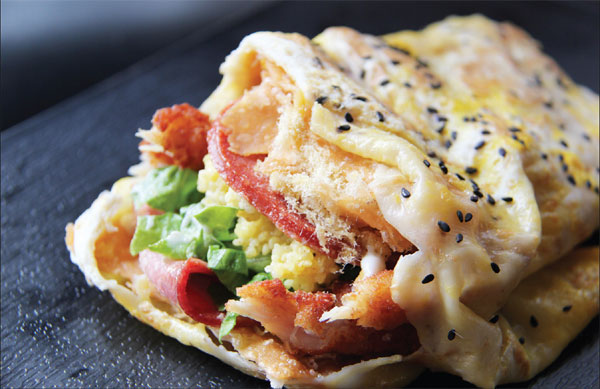Chinese pancake travels the world

Editor's Note: China is divided into as many culinary regions as there are different ethnic groups. Its geographical diversity and kaleidoscopic cultural profiles contribute to the unending banquet of flavors.
It started with an enterprising vendor outside the hallowed gates of Harvard University in Cambridge, Massachusetts. Then food trucks in New York, Washington, San Francisco, Chicago and Seattle picked up the trend. Before long, the hottest fast food in these cities was a Chinese crepe.
Jianbing became a buzzword both in China and abroad.
| Crispy grain jianbing, originally from Shandong, is like a Chinese hamburger. Photos Provided to China Daily |
The Chinese wondered, what's all the fuss about? We eat it every day. The pancakes are standard breakfast food from Shandong to Tianjin and a host of cities in between. It's cheap, good and delicious to boot.
Originally from Shandong, these crispy grain crepes are made up of any variety of cereals, from wheat to millet, buckwheat and even rice.
Every vendor has his or own secret grain combination. It really doesn't matter what, as long as the end result is a thin, crisp crepe that can be sauced up and wrapped around a crispy cruller or wheat cracker. Sometimes lettuce or a salad of fragrant herbs are added.
Condiments include chili sauce, hoisin sauce or the sweet sauce used for Peking duck, and various chopped pickled vegetables. Traditionally, it uses no meat, although an egg is scrambled onto the pancake before it is quickly folded up and delivered into the hands of waiting customers.
With its growing popularity, the jianbing is taking on a life of its own at home and abroad.
Inspired by its growing popularity abroad, chefs at home are taking it off the streets and into restaurants.
In Chengdu, Sichuan, for example, a young chef is taking up the jianbing challenge.
Qi Songcheng, 34, is a Shandong native and a highly trained Chinese chef. He was recruited by a high-end banquet outlet in Chengdu in 2009.
By 2015, however, the restaurant was severely affected by the frugality guidelines sent out by the central government when, as a result, almost nine out of 10 eateries of such caliber were forced to close.
Qi decided to strike out on his own and start his own business. That meant he had to identify a vacuum in the competitive Sichuan food and beverage industry. And he did.
"At that time, I had three choices. I could do noodles, jianbing or roujiamo, the Shaanxi hamburger. The market at that time was a fresh slate and so I decided on jianbing."
His jianbing restaurant was called Wujiandao, the middle character playing on the jianbing name and the whole punning on a very famous Hong Kong ghost-catcher film.
As a trained chef in Chinese classical cuisine, Qi had no experience making jianbing, other than the fact that he is from Shandong.
To perfect his recipe, he used up 100 kg of flour, playing with the dry and wet combinations until he finally got what he wanted, a crisp crepe pliable enough to wrap around some unusual fillings.
"I am a Shandong native with a hearty appetite. That's why my jianbing are a little different from the ones in Beijing and Tianjin."
For one, Wujiandao uses the best durum wheat for its pancakes. Perhaps they also use a bit of rice flour to crisp them up, but they're not telling. But they definitely do not used mixed grains, because consistency in quality is so much harder to control.
"We cater to the younger palates and try to find a comfort zone they can accept. That's why our pancakes use iceberg lettuce, mayonnaise, bacon, ham, cheese, chicken fillet, beef shortribs."
In fact, Qi sees his five-star jianbing more as Chinese hamburgers in this culinary crossover.
He must have hit on a right spot, because the jianbing food fad is currently spreading rapidly through Chengdu. But Qi is unfazed.
"You keep ahead of competition with one single word. Quality. Quality in ingredients, quality in cooking - that will keep you leading the copycats."
We discussed why jianbing, of all the Chinese street food, has found resonance in both the West and the domestic market.
First, it is the flavor and texture. The pancakes are crisp and crunchy, made of whole grain, and its filling of egg and vegetables make a nice balanced meal without being too heavy.
It's also freshly made. Jianbing cannot be prepared beforehand and must be made on the spot as orders come in. There is really nothing better to whet the appetite than watching your meal prepared before your eyes.
And, it is fascinating to watch as it all takes shape.
Jianbing is made on a large flat griddle. A large ladle of batter goes on the oiled surface and the jianbing master quickly smooths out the crepe with a few practiced moves using a nifty wooden squeegee.
As the crepe crisps, an egg is broken over it and spread out thinly. Finally, sweet and chili sauces are wiped on before a crispy cracker is placed in the middle. The crepe is then expertly folded around and handed piping hot to the eager diner.
Jianbing is also the perfect food on the run, since it is largely an order-and-go snack.
And like our innovative chef's jianbing in Chengdu, it can also have any number of different fillings packed into it. Already we're seeing ham and cheese, even shredded Peking duck on the menu.
paulined@chinadaily.com.cn
Try making your own jianbing at home
1 cup all-purpose flour
2 tablespoons corn flour
2 tablespoons rice flour
1 teaspoon baking soda
Cold milk
Eggs
Chopped coriander
Hoisin sauce
Chili sauce
Cornflakes
Combine the flours and baking soda together and add enough cold milk to create a dropping consistency. Allow the batter to sit in the fridge, preferably overnight.
Heat up a flat, lightly oiled nonstick frying pan and ladle enough batter for a thin layer on the bottom. Fry over medium heat until the edges start to curl. Loosen the pancake by shaking the pan, and with the help of a spatula.
Crack an egg onto the crepe and spread out thinly.
Spread your choice of hoisin or chili sauce into the crepe.
Add a handful of cornflakes on the crepe, add chopped coriander and quickly bring the sides over into a square. Serve hot.
You can also add your choice of filling - grated cheese, chopped ham, cooked minced meat, a salad of herbs.
The secret is to have your family waiting to eat the freshly cooked crepes so they are crisp and hot.

(China Daily Africa Weekly 08/11/2017 page19)
Today's Top News
- China to boost high-quality development in national development zones
- Xi extends condolences over death of former Vietnamese president
- Ukraine crisis a lesson for the West
- Autonomous networks driving the progress of telecom sector
- China launches cargo drone able to haul up to 1.2 tons
- Key role of Sino-German ties stressed































